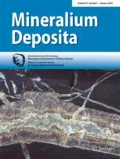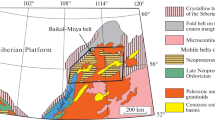Abstract
Lead isotope ratios of galena from the carbonate-hosted massive sulphide deposits of Kabwe (Pb-Zn) and Tsumeb (Pb-Zn-Cu) in Zambia and Namibia, respectively, have been measured and found to be homogeneous and characteristic of upper crustal source rocks. Kabwe galena has average isotope ratios of 206/204Pb = 17.997 ± 0.007, 207/204Pb = 15.713 ± 0.010 and 208/204Pb = 38.410 ± 0.033. Tsumeb galena has slightly higher 206/204Pb (18.112 ± 0.035) and slightly lower 207/204Pb (15.674 ± 0.016) and 208/204Pb (38.276 ± 0.073) ratios than Kabwe galena. The isotopic differences are attributed to local differences in the age and composition of the respective source rocks for Kabwe and Tsumeb. The homogeneity of the ore lead in the two epigenetic deposits suggests lead sources of uniform isotopic composition or, alternatively, thorough mixing of lead derived from sources with relatively similar isotopic compositions. Both deposits have relatively high 238U/204Pb ratios of 10.31 and 10.09 for Kabwe and Tsumeb galenas, respectively. These isotope ratios are considered to be typical of the upper continental crust in the Damaran-Lufilian orogenic belt, as also indicated by basement rocks and Cu-Co sulphides in stratiform Katangan metasediments which have a mean μ-value of 10.25 ± 0.12 in the Copperbelt region of Zambia and the Democratic Republic of Congo (formerly Zaire). The 232Th/204Pb isotope ratios of 43.08 and 40.42 for Kabwe and Tsumeb suggest Th-enriched source regions with 232Th/235U (κ-values) of 4.18 and 4.01, respectively. Model isotopic ages determined for the Kabwe (680 Ma) and Tsumeb (530 Ma) deposits indicate that the timing of the mineralisation was probably related to phases of orogenic activity associated with the Pan-African Lufilian and Damaran orogenies, respectively. Galena from the carbonate-hosted Kipushi Cu-Pb-Zn massive sulphide deposit in the Congo also has homogeneous lead isotope ratios, but its isotopic composition is comparable to that of the average global lead evolution curve for conformable massive sulphide deposits. The μ (9.84) and κ (3.69) values indicate a significant mantle component, and the isotopic age of the Kipushi deposit (456 Ma) suggests that the emplacement of the mineralisation was related to a post-tectonic phase of igneous activity in the Lufilian belt. The isotope ratios (206/204Pb, 207/204Pb, 208/204Pb) of the three deposits are markedly different from the heterogeneous lead ratios of the Katangan Cu-Co stratiform mineralisation of the Copperbelt as well as those of the volcanogenic Nampundwe massive pyrite deposit in the Zambezi belt which typically define radiogenic linear trends on lead-lead plots. The host-rock dolomite of the Kabwe deposit also has homogeneous lead isotope ratios identical to the ore galena. This observation indicates contamination of the Kabwe Dolomite Formation with ore lead during mineralisation.
Similar content being viewed by others
Author information
Authors and Affiliations
Additional information
Received: 8 September 1997 / Accepted: 21 August 1998
Rights and permissions
About this article
Cite this article
Kamona, A., Lévêque, J., Friedrich, G. et al. Lead isotopes of the carbonate-hosted Kabwe, Tsumeb, and Kipushi Pb-Zn-Cu sulphide deposits in relation to Pan African orogenesis in the Damaran-Lufilian Fold Belt of Central Africa. Mineral. Deposita 34, 273–283 (1999). https://doi.org/10.1007/s001260050203
Issue Date:
DOI: https://doi.org/10.1007/s001260050203



